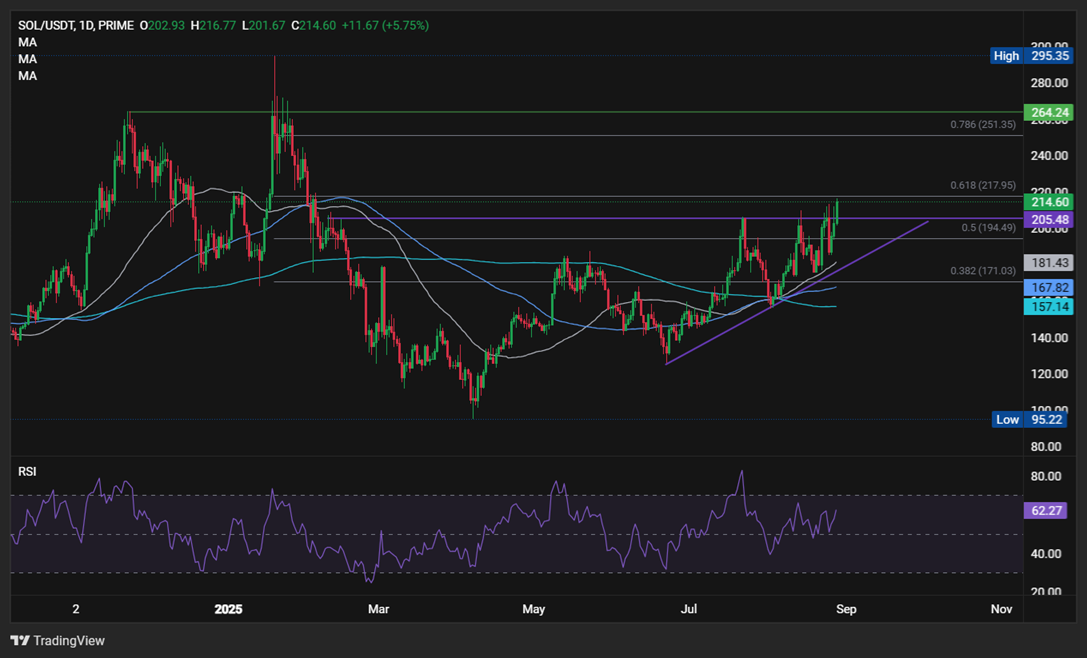Solana has reached its highest level since February, rising to a high of 216 as the price extends its recovery from the August low. The price has rallied over 3% this week while Bitcoin is on track to book losses of 2.5%. Solana has outperformed across the month and is set to book gains of 22% in August, while BTC is on track to fall 2.75% this month despite reaching a fresh record high of 124.4k mid-August.
The solid performance from Solana comes amid a combination of technical, fundamental, and macro factors.
A dovish lean from Powell
On the macros front, a dovish lean from Federal Reserve Chair Jerome Powell at the Jackson Hole Symposium boosted risk assets. The prospect of lower interest rates is beneficial for risk assets owing to increased liquidity. While BTC has failed to benefit from the improving macro backdrop, other altcoins have and are also benefiting from a rotation out of BTC.
SOL ETF optimism & corporate adoption
Another major catalyst for SOL gains has been growing optimism surrounding the approval of US Solana ETFs. Major asset managers, including Grayscale and Invesco Galaxy, submitted filings for Solana ETF, leading to a surge in approval probabilities to open 90%.
Meanwhile, corporate adoption has been another driver of SOL demand. Galaxy Digital, Multi-Coin Capital, and Jump Crypto are seeking to raise $1 billion to acquire Solana, creating the largest corporate treasury dedicated to the token to date. Meanwhile, Sharp Technology announced that it has priced a $400 million private placement aimed at establishing its own Solana-focused treasury strategy. Combined, these two efforts represent a potential $1.4 billion increase in demand for Solana, reinforcing scarcity.
Solana’s institutional and corporate appeal is underpinned by its technological differentiation. In 2025, 7,500 new developers joined the ecosystem, and with 3.8 million active wallets per day, the network is outpacing its competitors in adoption and transaction volume. Decentralised exchanges (DEX) on Solana now account for 48% of retail crypto trading activity, underscoring the popularity of its user-friendly infrastructure and low-cost execution.
Smart money inflows
SOL has experienced large smart money inflows over the past day. According to Nansen smart money, which is known for making profitable bets, increased its exposure by $4.77 million, marking an almost 20% increase. This takes smart money holding SOL to $24.1 million, the highest among tracked assets.
Spot investors have followed a similar pattern, adding $798,000 worth of SOL over the same period. Should this trend continue and SOL continue to be moved into private wallets, it would confirm bullish sentiment.
SOL technical test

SOL/US is breaking out of its bullish triangle pattern. The price has broken above 205, a resistance level that had been tested three times over the past six weeks. The breakout above 205, combined with the RSI above 50 and bullish crossover on the MACD, keeps buyers hopeful of further gains above 220 towards 265, the 2024 high. On the downside, a close below 205 could open the door to 184, the weekly low and May high. Below here 175, the rising trendline support comes into play.
Trading involves risk.
The content provided here is for informational purposes only. It is not intended as personal investment advice and does not constitute a solicitation or invitation to engage in any financial transactions, investments, or related activities. Past performance is not a reliable indicator of future results.
The financial products offered by the Company are complex and come with a high risk of losing money rapidly due to leverage. These products may not be suitable for all investors. Before engaging, you should consider whether you understand how these leveraged products work and whether you can afford the high risk of losing your money.
The Company does not accept clients from the Restricted Jurisdictions as indicated in our website/ T&C. Some services or products may not be available in your jurisdiction.
The applicable legal entity and its respective products and services depend on the client’s country of residence and the entity with which the client has established a contractual relationship during registration.




